Workflow action buttons are the way a reviewer can tell an app what they would like to do to the record they are reviewing. This Workflow Actions Advanced article builds upon the basics covered in the article Workflow 2 – Action Buttons (Basics). Please read the basics article for information about what action buttons are and how to create them.
Note: This page is about the new workflow user interface (UI), found on the Workflow New tab. The original workflow UI is still available for now, on the ‘Workflow Old’ and ‘Security Old’ tabs that follow it. The available features are similar, but a few of the latest minor features are only available via the new workflow UI.

Manage Action Buttons

Click and drag the six (6) dots icon on the far left of the action button to reorder the list of buttons. When displayed on records, while using the app, the buttons will display in list order from left to right, starting with the first button in the list.
You can edit the button name by selecting it here. This is one of two places you can edit the name – the other being the Format section of the button properties.
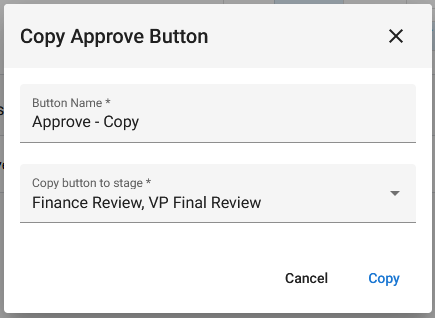
Properties opens the button properties.
Copy will duplicate the button and all of it’s properties, and allow you to add it to any stage(s), including the current stage.
Remove deletes the button.
Configuring Action Buttons
There are a lot of possible configuration options for workflow action buttons. To help get the essential options covered more simply, we have split the documentation for workflow action buttons into two articles. This ‘Basics’ article, and the subsequent ‘Advanced’ article (Workflow: 3 – Action Buttons (Advanced)). We will cover the most commonly used action button features here, and the more advanced ones in the second article.
After creating an action button, the button properties panel will immediately open on the right. To edit the settings of an existing action button, click on the ‘Properties‘ icon on the button.

The button properties are broken down into four tabs:
- Actions: Define what the button should do, the actions to run when the button is clicked.
- Security: Configure button visibility.
- Dialog: Settings for an optional confirmation dialog.
- Format: Define the visual appearance of the button.
Actions Tab
There are two classes of actions: Default Actions and Conditional Actions.
Default Actions run when the action button is clicked, unless a conditional action replaces it. If you have no conditional actions, the Default Actions will always run. There can be multiple default actions, such as moving the record to the next workflow stage and also sending a notification email.
Conditional Actions have a logical test associated with them, such as “Department field contains Sales” or “Total Value field is greater than 10,000”. If this test is true, then the associated conditional action(s) will run. There can be multiple conditional actions, and each can have more than one condition that must be met.
At the top of the Actions Tab are two options that control what happens when one or more conditions do match the current situation. The options, and the effect they have, are:
- Run the actions for the first condition that matches, otherwise run the default actions: Only one set of actions will be run. The default actions will run if no conditions match. The matching condition’s actions will run if only one condition matches. If more than one condition matches, then only the first matching one in the listed order will run.
- Run the actions for all the conditions that match, including default actions: More than one set of actions might run. The default actions will always run, plus the actions from any matching condition’s actions.
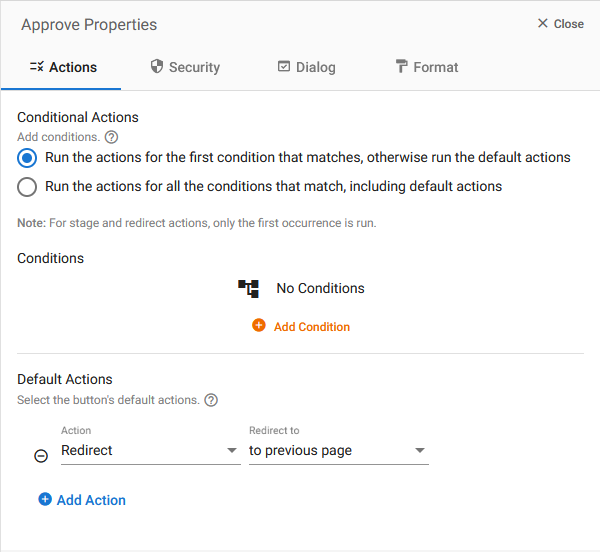
Note: If you have multiple change stage or redirect actions run at the same time, only the first occurrence will run.
Action Options
There are a total of 10 types of actions, but we will cover the four most commonly used ones here (The rest will be covered in the next article):
There are 11 available types of actions:
| Action Type | Description |
| Change Stage | Move the record to a new workflow stage and set the workflow status accordingly, e.g. Draft to Manager’s Approval or VP Approval to Rejected. Once you select ‘Change Stage’ as the type, you will see the ‘Next Stage’ field. Select the desired stage the current record should move to when this button is clicked. Note: You can only change status to one other value, so there is no purpose for having multiple Change Stage actions. Therefore, once Change Stage has been selected, it will no longer appear in the Type selector for that set of actions. |
| Send Email | Allows you to select or create an email template so that an email message is sent to interested parties when the workflow action button is pressed. Once you select ‘Send Email’ as the type, you will see the ‘Select’ field to allow you to select the desired email template, or create a new one by selecting ‘+ New’ from the top of the list. Details for working with email templates to create customized notification messages are shown here: Email Templates. |
| Generate PDF | Allows you to select or create a PDF template so that a PDF document is generated and downloaded to the users download folder, when the workflow action button is pressed. Once you select ‘Generate PDF’ as the type, you will see the ‘Select’ field to allow you to select the desired PDF template, or create a new one by selecting ‘+ New’ from the top of the list. Details for working with PDF templates are shown here: PDF Templates. |
| Redirect | Allows you to select what should be seen by the user after the action button is pressed, e.g. go back to the prior view or open a specific form. Select between the following options: – to viewing record (Keeps you looking at the record, but puts it into View mode) – to editing record (Keeps you looking at the record, but puts it into Edit mode) – to another form – to a page – to a view – to previous page (Usually takes you back to the view from which the record was opened or created) – to dashboard (Takes you to the applications dashboard) Then, if ‘to another form’, ‘to a page’ or ‘to a view are selected, pick the desired Form, Page or View from the supplied list. |
| Assign User to Role | Allows you to set the value of a dynamic role, e.g. setting the Approving Manager role to have the value of the Manager field on the current record. Dynamic roles allow you to assign named people to have a role specifically for this record, so Approving Manager could have a different name value for different records. (Traditional managed roles always have the same value for any record, as they are defined at the application design level.) Once you select ‘Assign User to Role’ as the type, you will see the ‘Select’ field to allow you to select the desired Dynamic Role. Once the role is selected, an additional ‘Select’ field appears for you to select the name of the field to get the user name(s) value from. Only User or Multiple Users fields display in the list, along with the system fields Created By and Updated By. |
| App Notification | Allows you to select or create an app notification template so that an in-app notification message is sent to interested parties when the workflow action button is pressed. (This creates an ‘App Notification’ type of action that can then be seen in the list of Actions.) Once you select ‘App Notification’ as the type, you will see the ‘Select’ field to allow you to select the desired notification template, or create a new one by selecting ‘+ New’ from the top of the list. Details for working with app notifications to create customized notification messages are shown here: Email Templates. |
| Create Record | Allows you to create a new record, in the current app or any other GW Apps app, based on information from the current record and additional entered values. (This creates an ‘Create Record’ type of action that can then be seen in the list of Actions.) Once you select ‘Create Record’ as the type, you will see the ‘Select’ field to allow you to select the desired create record action, or create a new one by selecting ‘+ New’ from the top of the list. Clicking on ‘+ New’ will open a dialog box so you can define the new create record action. Once you close the dialog box, you will see the create record action’s name displayed in the ‘Select’ field. (For more details on creating create record actions, please see the article Actions) |
| Update Record | Allows you to update an existing record, in the current app or any other GW Apps app, based on information from the current record and additional entered values. (This creates an ‘Update Record’ type of action that can then be seen in the list of Actions.) Once you select ‘Update Record’ as the type, you will see the ‘Select’ field to allow you to select the desired update record action, or create a new one by selecting ‘+ New’ from the top of the list. Clicking on ‘+ New’ will open a dialog box so you can define the new update record action. Once you close the dialog box, you will see the update record action’s name displayed in the ‘Select’ field. (For more details on creating update record actions, please see the article Actions) |
| Webhook | Allows you to trigger a webhook action on an external system that supports webhooks via its API.. (This creates an ‘Webhook’ type of action that can then be seen in the list of Actions.) Once you select ‘webhook’ as the type, you will see the ‘Select’ field to allow you to select the desired webhook action, or create a new one by selecting ‘+ New’ from the top of the list. Clicking on ‘+ New’ will open a dialog box so you can define the new webhook action. Once you close the dialog box, you will see the webhook action’s name displayed in the ‘Select’ field. (For more details on creating webhook actions, please see the article Actions) |
| Microsoft Word | Allows you to select or create a MS Word template so that a MS Word document is generated and either sent as an attachment to an email (using an email template) or uploaded to a specified attachment field on the current record. (This creates an ‘Microsoft Word’ type of action that can then be seen in the list of Actions.) Once you select ‘Microsoft Word’ as the type, you will see the ‘Select’ field to allow you to select the desired Microsoft Word action, or create a new one by selecting ‘+ New’ from the top of the list. Clicking on ‘+ New’ will open a dialog box so you can define the new Microsoft Word action. Once you close the dialog box, you will see the Microsoft Word action’s name displayed in the ‘Select’ field. (For more details on creating webhook actions, please see the article Actions) |
Security Tab
The Security Tab is where you can define when the button should display and when it should be hidden. Additional role and workflow stage based button visibility settings can be configured in the Field Security. The options here affect all users no matter what their role.
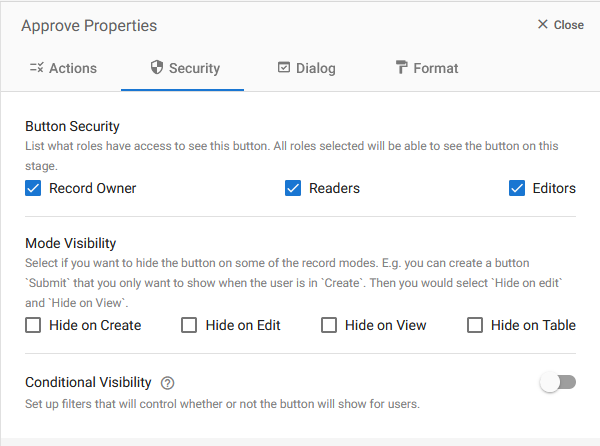
Button Security defines which roles have the ability to see the button at this workflow stage. If you add a new role to your application after creating an action button, the new role will not automatically have access to view the button, you must check the box manually.
Mode Visibility allows you to hide the button when a record is in specific modes, e.g., during Create, Edit, View, or in the Action Column of a view (Hide on Table).
Conditional Visibility defines the visibility of button based on whether or not certain conditions are met, e.g., hide the button if the value of the “Purchase Total” field is less than 10,000.
Dialog Tab
In this tab you can add an optional confirmation dialog to your action button. With this option, when a user clicks the action button a confirmation box will pop-up before running the action. The user may cancel, continue with the action, and optionally fill out up to three (3) specified fields from your form before continuing.
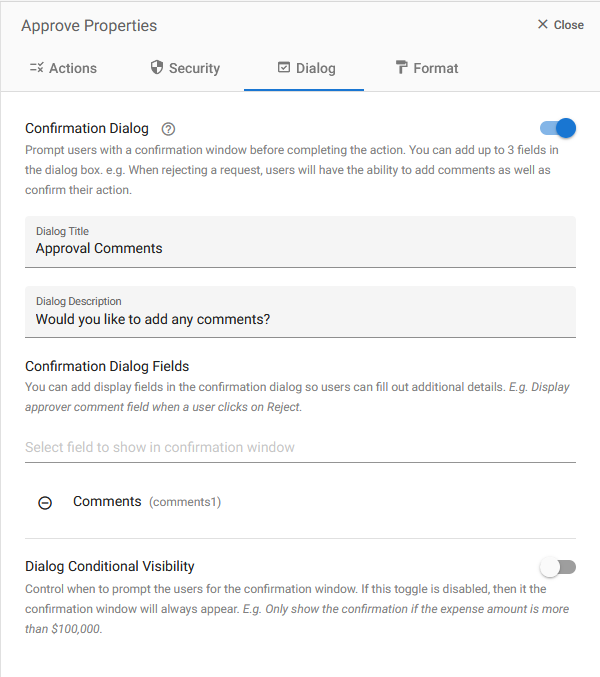
Dialog Title will display at the top of the dialog.
Dialog Description will display below the title in the dialog.
Confirmation Dialog Fields allows you to add up to three (3) fields from your form to the dialog. Depending on the field security, these fields may be edited or filled out within the dialog.
Dialog Conditional Visibility determines if the dialog will display depending on whether or not specific conditions are met.
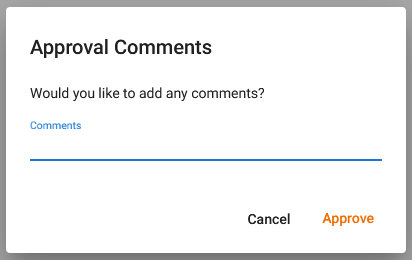
Format Tab
The Format tab is where you define the visual appearance of your button. The top-right corner displays a preview of changes as you make them.
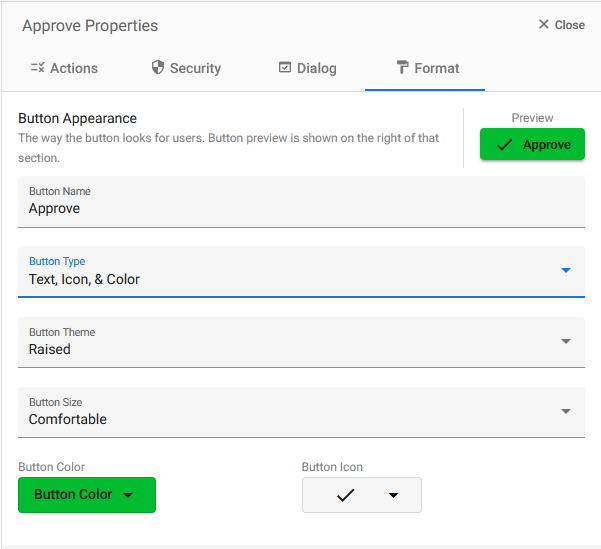
Next Steps
| Below are links to articles that cover the other main areas of creating a workflow: |
| Workflow Stages |
| Workflow Security |
| Email Templates |
| Below are the links to the episodes of Building an Expense Reports App tutorial series that include descriptions of setting up a workflow: |
| Part 5 – Expense Reports App – Workflow |
| Part 6 – Expense Reports App – Security |
